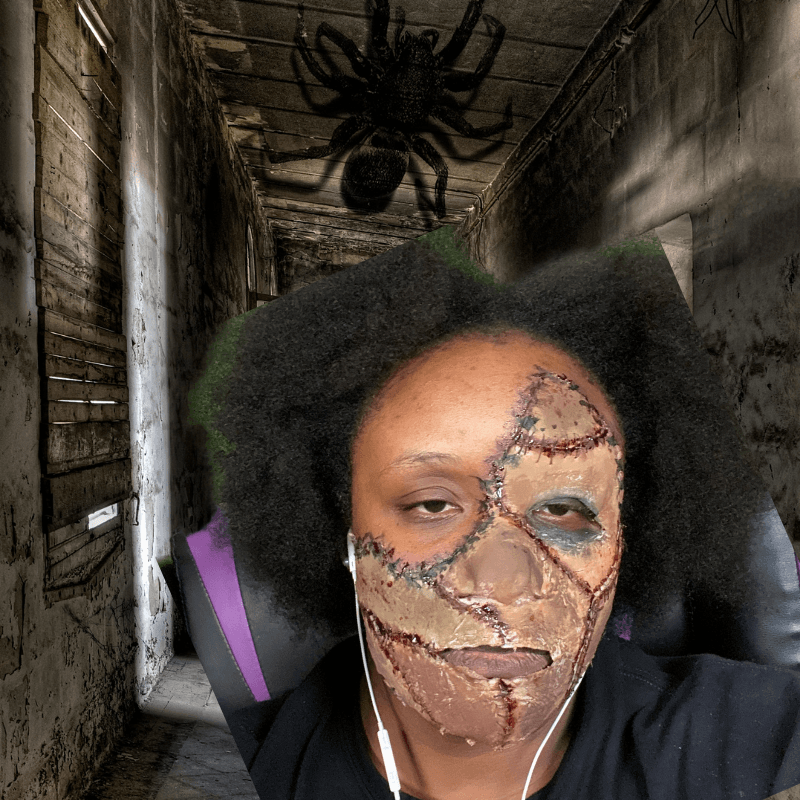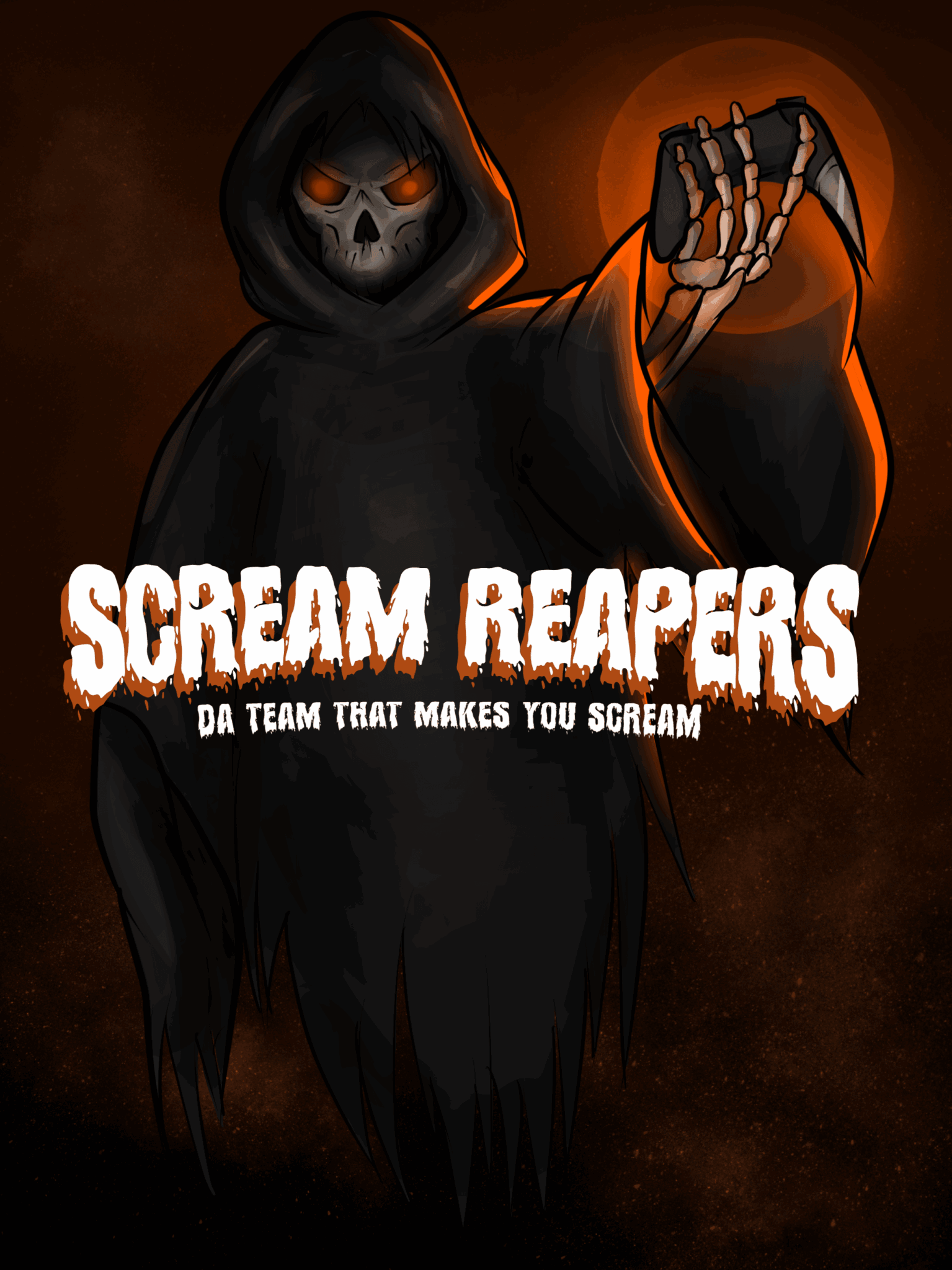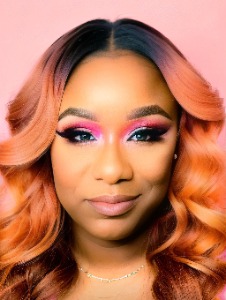Alright – so today we’ve got the honor of introducing you to DaFemalePhenom. We think you’ll enjoy our conversation, we’ve shared it below.
Alright, DaFemalePhenom thanks for taking the time to share your stories and insights with us today. Do you wish you had waited to pursue your creative career or do you wish you had started sooner?
If I could go back in time, I might say I wish I’d started sooner, but honestly, I think I started at the exact right moment for me.
My love for horror started early, at six years old. While other kids were into cartoons and Barbie dolls, I was obsessed with gaming, wrestling (thanks to my mom, aunt, and grandmother), monsters, slashers, and everything creepy. I saw Halloween (1978) way younger than I probably should’ve, and it changed something in me. That eerie music, the tension, the mask—it stuck. Every night when my dad came home from his late shift, we had a ritual: he’d make me a ham sandwich, orange slices, crab Utz chips, and a juice box. We’d sit together and watch horror movies. That was our bond. Horror became more than a genre, it became my comfort zone, my escape, my identity.
The real turning point for me was An American Werewolf in London. Rick Baker’s werewolf transformation scene flipped a switch in my brain. I realized someone made that. It wasn’t just movie magic; it was brilliant, hands-on artistry. I became obsessed with special effects makeup. My parents were incredibly supportive; they let me play horror games, experiment with SFX, and fully embrace being the weird kid who asked for fake blood instead of toys.
But even with that love growing inside me, I didn’t fully commit to my creative path until my mid-20s. Up to that point, I was just trying to survive, working jobs, doing what I thought I was supposed to do. One day, I picked up a brush and some latex and said, “I’m going to try this, and I’m going to be good at it.”
I even applied for Face Off on Syfy. But when I saw the other artists and their portfolios, I psyched myself out. That fear, that feeling of not being good enough, got in my way. If I had started earlier, maybe I would’ve developed more technical skill, built confidence sooner, maybe even taken that audition all the way. But the truth is, the version of me back then wasn’t ready, not mentally, not emotionally.
If I’d started later? I probably wouldn’t have started at all. Life gets louder, responsibilities stack up, and doubt creeps in stronger. I caught myself at the perfect moment, young enough to dream big, old enough to take it seriously.
So no, I don’t regret my timing. My story is messy, personal, and fully mine. I needed those years to build the weird, haunted, passionate voice I have now, and honestly, I wouldn’t change that for anything.


Great, appreciate you sharing that with us. Before we ask you to share more of your insights, can you take a moment to introduce yourself and how you got to where you are today to our readers.
For those who may not know me yet, I’m a horror enthusiast, gamer, wrestling fan, true crime junkie, special effects makeup artist, and the founder of Scream Reapers, a horror-based stream team made up of Final femmes and women of color who are pushing boundaries in a genre that often overlooks us. My work lives at the intersection of horror, creativity, community, and representation.
My love for horror started young. I saw Halloween (1978) when I was six years old and was instantly hooked. While most kids were watching cartoons or playing sports, I was studying monsters, slashers, and creature features. I wasn’t interested in fitting in , I was obsessed with transformation and terror. The moment I saw Rick Baker’s legendary werewolf transformation in An American Werewolf in London, I knew I wanted to bring monsters to life. With the support of my parents, I explored special effects makeup early on and began developing the skills to turn nightmares into art.
Gaming came naturally, too. Horror games became my escape, my adrenaline fix, and my creative fuel. Eventually, I realized there was space to merge both passions, makeup and gaming, into something original. I started streaming horror games, building characters, creating content that blended visuals and gameplay, and putting my signature on the genre.
That’s when Scream Reapers was born. I created the team because I didn’t see enough femmes and women of color being celebrated in horror spaces. We’ve always been fans, creators, and visionaries in this genre, but we’re often sidelined or invisible. Scream Reapers is our answer to that. We stream horror games, create bold makeup looks, collaborate on creative projects, and show the world that horror belongs to all of us. It’s a team, a community, and a movement.
As a solo creator, I provide custom special effects makeup for streamers, content creators, indie filmmakers, haunted attractions, and events. From blood-drenched transformations to cinematic creature designs, I craft each look with story and impact in mind. I also create original horror-based content across streaming platforms, combining makeup, gameplay, commentary, and community-building.
What sets me apart is that I’m doing it because it’s who I am. Horror is my language. It’s where I found my voice. Every creature I build, every game I play, every stream I host, it’s all deeply personal. I blend old-school practical effects with modern digital storytelling, and I stay rooted in the culture that shaped me.
What am I most proud of? Building Scream Reapers from scratch. Turning an idea into a safe, expressive, badass space where femmes and women of color can be exactly who they are, scary, silly, creative, powerful. We’re not here to fit a mold. We’re here to break it.
If you’re just discovering me or Scream Reapers, here’s what you need to know: we’re not background characters. We’re the final girls, the killers, the monsters, the creators, and the storytellers. Whether you’re here for jaw-dropping SFX, diverse horror content, or a community that doesn’t play by the rules, we’ve got you.
We’re here to scare, slay, and take up space. And we’re just getting started.


Is there mission driving your creative journey?
Yes, there’s a clear mission driving my creative journey, and it’s rooted in both passion and purpose. I’ve always seen horror as more than just entertainment—it’s been my escape, my therapy, my identity. And now, it’s my way of creating space for others like me to exist loudly and fearlessly in a genre that hasn’t always welcomed us.
My ultimate dream? To star as a final girl in a horror film, the one who survives, fights back, and flips the script. But not just that, I want to be behind the camera too. One of my biggest goals is to one day work alongside or assist some of the legends who shaped this industry: Rick Baker, Tom Savini, Jason Baker, Greg Nicotero, and Ve Neill. They’re the masters of transformation, and I’d give anything to absorb their craft firsthand, even just as a sponge in the room. Their work taught me that monsters are made, not just born, and that creating fear is an art form.
What drives me creatively is that blend: performance and transformation. I want to tell stories through characters I become and characters I build. I want to make horror that’s inclusive, imaginative, and unforgettable. And I want to prove that femmes and women of color aren’t just worthy of space in horror, we own it.
Whether I’m doing SFX makeup, streaming a horror game, or leading my team, Scream Reapers, I’m doing it with the mission to shift culture, build community, and create monsters that make people feel something. Terror, awe, recognition, whatever it is, I want it to hit.
That’s the mission: to survive, to slay, and to make sure the next generation of horror creators knows there’s room for them too.


What can society do to ensure an environment that’s helpful to artists and creatives?
In my view, if society wants to support artists and build a thriving creative ecosystem, it needs to start by valuing creativity as labor, not just a hobby or side hustle. That means fair pay, proper credit, and real opportunities( no matter the size of your viewership or status), not just exposure or promises. Artists fuel culture. We build the visuals, sounds, stories, and worlds people escape into, and yet we’re often treated as disposable or secondary.
We also need access, especially for marginalized creatives. More funding, more mentorship programs, more grant opportunities specifically for femmes, people of color, and those in nontraditional genres like horror. A lot of us don’t come from privilege or connections. We’re building everything from the ground up. Support systems need to reflect that.
Education and representation matter too. Schools should be teaching creative careers as viable paths, not as pipe dreams. And platforms, whether it’s streaming sites, networks, or social media, need to do better at amplifying diverse voices, not just recycling the same faces.
Lastly, community over competition. Society thrives when artists collaborate, uplift each other, and are given safe spaces to take risks without being punished for failing. Creativity isn’t just about the end product; it’s about freedom, growth, and expression.
If you want more artists creating boldly, you have to give them the room, resources, and respect to do it. It’s that simple.
Contact Info:
- Website: https://www.dafemalephenom.com
- Instagram: https://www.instagram.com/dafemalephenom
- Facebook: https://www.facebook.com/dafemalephenom
- Linkedin: https://www.linkedin.com/in/dafemalephenom
- Twitter: https://x.com/DaFemalePhenom
- Youtube: http://www.youtube.com/c/DaFemalePhenom
- Other: Twitch – https://www.twitch.tv/dafemalephenom




